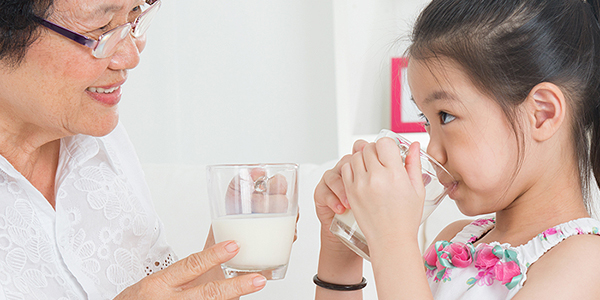Promotional Features
DSM: How brands can partner to innovate and grow in the kids nutrition space
Rising economic prosperity in Asia over the past 30 years has driven major improvements in early life nutrition. However, there is still significant scope to improve the nutritional intake of children in even the most economically developed countries. To foster discussions about how to achieve the next set of breakthroughs, DSM gathered experts from nutrition, science, market research and industry at the Bright Kids Nutrition Conference.
At the Bright Kids Nutrition events, held in Auckland, New Zealand and Sydney, Australia, experts in early life nutrition from DSM and other organizations shared data on the need for new products and discussed how food companies can drive further improvements in early life nutrition.
Here, we present the top five takeaways from the events.
Kids nutrition is clear market opportunity
Data generated by DSM and organizations including Mintel show there are a multiple Asia-wide and country-specific opportunities open to food and nutrition manufacturers. In China, for example, 74% of parents prefer child-specific milk, creating a clear market opportunity for targeted products.1
The rewards for food and supplement manufacturers that develop innovative products to meet these market needs may be significant. In China, sales of premium kids nutrition products priced at twice the market average grew 46% in the year up to February 2019.2
Despite the demand for products that meet children’s nutritional needs, relatively few new products aimed at kids are coming to market. In the year up to July 2019, just 5% of food product launches in Asia Pacific targeted children aged from birth up to 12 years old. Certain subsectors are more active — 21% of launches in China targeted children — but the data suggests there is untapped demand.
Cultural and human forces shape nutrition
Surveys run by DSM show that the market opportunities vary somewhat from country to country due to the effect of cultural and human forces on the priorities of parents.
For example, while parents in both Australia and China identified mental health as the top priority for their child’s development, their specific goals differ. Among Australian parents, preventing anxiety is the main goal, whereas their Chinese counterparts prioritize maintaining good mood.
In other areas, the differences are more fundamental. In China, 60% of parents are worried about the eye health of their kids, compared to just 38% in Australia. In contrast, Australian parents are more concerned about how much high-quality sleep their kids get. At 34%, the proportion of Australian mums attracted by the health claim “supports quality of sleep” is well above the global average.
These differences reflect the cultures of the countries. To deliver maximum benefits, food and nutrition companies need to understand how cultural and human forces shape nutritional goals.
Nutritional gaps still exist even in developed markets
While parents across Asia have different nutritional goals for their kids, the underlying challenges they face are similar. Economic development has significantly decreased severe malnutrition but all countries continue to face significant nutrient gaps.
In China, insufficient intake of calcium and vitamins A, B and C is seen in children aged from four to 17 years old.3 Australia and New Zealand face similar problems. In Australia, 84% of girls and 67% of boys aged 12 to 13 years old consume too little calcium.4
These countries, and others in Asia, are also united by an obesity problem. In New Zealand, around 40% of children are overweight.5 The proportion of overweight kids in China is lower but the trend is alarming. In 1975, 1% of girls were overweight. By 2016, the figure had soared to 35%.
Viewed in conjunction with the data on parental priorities, the nutritional gap figures provide food and nutrition companies with a roadmap for improving health and achieving optimal nutritional outcomes for children across Asia.
Parents will act to mitigate nutritional gaps
Evidence of how parents act to mitigate nutritional gaps is the other key input to the roadmap. When parents learn of nutritional gaps many act to address them but the exact steps they take vary from country to country.
In Australia, 54% of parents take actions to improve the brain health of their children, with 37% of people adjusting diet and nutrition and 12% giving supplements. Chinese parents are more interventionist. More than 80% of parents take action. The difference is underpinned by greater nutritional actions and provision of supplements.
Similar trends are seen across the dataset. Australian and Chinese parents share the view that the maintenance of a healthy diet is critical to childhood health. However, 10% of Australian parents use supplements to mitigate concerns about their child not eating well, compared to 29% of their Chinese counterparts.
Overall, 97% of kids in China aged four to six years old take a supplement, compared to 68% in Australia. Similar differences in supplement use are seen in older children. Chewable tablets are the preferred format in both countries, followed by gummies.
Nutritional products need to taste great
Everyone knows it is important to eat well but many people struggle to maintain healthy habits. Annual survey results from the International Food Information Council Foundation going back seven years show consumers consistently prioritize taste and price when deciding which foods an drinks to buy.6 Children are no different. We all want food to taste great.
The recognition that great tasting products are needed to achieved sustained improvements in early life nutrition led DSM to prioritize work to make foods healthier while retaining the texture, taste and mouthfeel consumers demand.
That focus has led DSM to partner with food manufacturers to create customized solutions. This work leverages understanding of how color, flavor, lactase, texture modifiers, taste modulators and natural, high-intensity sweeteners can deliver both the sensory experience consumers desire and the nutritional profile they know they need.
Through such work, the food and supplement industries can spark another leap forward in childhood nutrition, building on the progress of recent decades to ensure more kids get optimized amounts of critical nutrients in great tasting products. In doing so, manufacturers stand to improve the health of children across Asia, resulting in near term and lifelong health benefits for millions of people.
To learn more about these consumer insights or tailored solutions for the kids nutrition segment, please reach out to your local DSM representative or visit https://www.dsm.com/markets/human-nutrition/en/early-life-nutrition.html.
References
1. Roux, C. Demand exists for child-targeted dairy in China. Mintel (2018). Available at: https://www.mintel.com/blog/food-market-news/demand-exists-for-child-targeted-dairy-in-china. (Accessed: 22nd October 2019)
2. Nielsen. Available at: https://www.nielsen.com. (Accessed: 23rd October 2019)
3. China Health and Nutrition Survey — China Health and Nutrition Survey (CHNS). Available at: https://www.cpc.unc.edu/projects/china. (Accessed: 21st October 2019)
4. c=AU, o=Commonwealth of Australia & ou=Australian Bureau of Statistics. Main Features - Calcium. 4364.0.55.008 / 2011-12 / Australian Health Survey: Usual Nutrient Intakes / Calcium / Summary (2015).
5. Rankings - Overweight > BMI > Data Visualisations > NCD-RisC. Available at: http://ncdrisc.org/overweight-prevalence-ranking-ado.html. (Accessed: 21st October 2019)
6. 2018 Food & Health Survey. IFIC Foundation Available at: https://foodinsight.org/wp-content/uploads/2018/05/2018-FHS-Report-FINAL.pdf. (Accessed: 26th November 2019)





